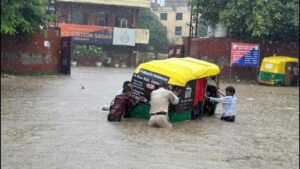Overnight rains left Mumbai submerged, schools shut, and residents stuck indoors. But the chaos wasn’t limited to the financial capital. Just days earlier, Gurugram, Delhi, Bengaluru, and Chennai faced similar scenes of waterlogged streets and stranded commuters. From luxury neighborhoods to crowded markets, Indian cities seem to have one weakness in common: even moderate rainfall can turn urban roads into rivers.

For residents like Nikunj Sabharwal in Juhu, Mumbai, monsoon means more than getting wet it’s a daily struggle. “I commute along SV Road to Andheri West regularly. During the rains, parts of this road become chest-deep waterways. I’ve seen NDRF boats evacuating people when flooding gets out of hand. Honestly, the Koli fishermen from nearby Versova could make a living just fishing inside the city. At this rate, the Navy might as well set up a monsoon command centre here,” he said, half-joking, half-frustrated.
The problem isn’t unique to Mumbai. Gurugram’s Millennium City was recently submerged after a 40-mm rainfall what local authorities had termed a “manageable shower.” Roads turned into mini-lakes, cars stalled, and residents waded through waterlogged streets, posting videos on social media that quickly went viral.
Delhi, Bengaluru, and Chennai aren’t far behind. The National Disaster Response Force (NDRF) reported over 50 flood-related rescues in Delhi in the past week alone. Bengaluru’s IT hubs faced temporary shutdowns as water entered ground floors of office complexes. In Chennai, low-lying areas along the Adyar River experienced knee-deep flooding, cutting off neighborhoods from the main roads.
Experts attribute the crisis to a combination of outdated drainage systems, rapid urbanization, and the city planning failures that ignore natural water channels. “Indian cities were never designed to handle these kinds of concentrated rainfall events,” said Dr. Ravi Shankar, a climate resilience specialist. “Most drains are old, blocked, or too small. Add unplanned construction on lakes, wetlands, and stormwater channels, and you get this result every monsoon.”
Some municipal authorities have responded with temporary measures like pumping water from major intersections and clearing clogged drains. However, residents complain that these efforts are reactive rather than proactive. “They come with pumps after we are already stranded,” said Anjali Mehra, a resident of South Delhi. “There’s no long-term plan to prevent flooding.”
The “Doobo-meter,” an informal city flood index created by urban analysts, highlights the severity of these events. According to the latest estimates, Gurugram, Mumbai, and parts of Chennai can see severe inundation with rainfall as low as 40-50 mm in 24 hours, whereas European cities of similar size handle double that without major disruption.
With climate change intensifying monsoon patterns and rainfall becoming more erratic, experts warn that the problem will only worsen. “Urban flooding is no longer an inconvenience; it’s a risk to life and livelihoods,” said Dr. Shankar. “Cities need comprehensive stormwater management, early warning systems, and better land-use planning before the next 40-mm test turns deadly.”
Residents are left hoping that policy-makers, engineers, and planners act fast. Until then, every monsoon brings the same scene: cars stuck, people wading through water, and city life on hold reminding everyone that India’s urban landscapes are still learning to live with the rain.
